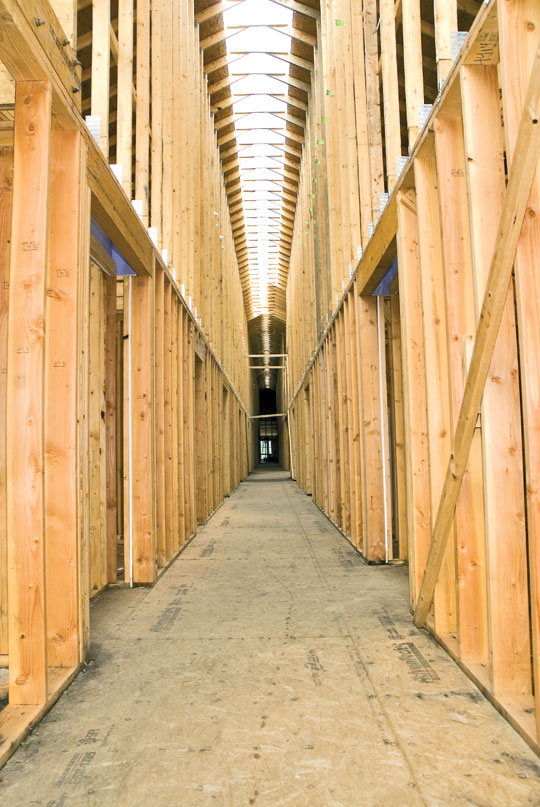The Makings of a Great Subfloor
High performance panels stand out in strength, moisture resistance and sustainability
![]() Continuing Education
Continuing Education
Use the following learning objectives to focus your study while reading this month’s Continuing Education article.
Learning Objectives - After reading this article, you will be able to:
- Identify four types of subfloor.
- Describe the characteristics that make for a safe, sound, sustainable subfloor.
- Explain the importance of Evaluation Service Report standards.
- Detail the implications of excessive moisture in a subfloor.
Probably no other element receives as much wear and tear in a building as flooring. What goes underneath the top flooring layer is critical in determining the performance and longevity of a building's entire flooring system. Used for structural and foundation support, subfloors ideally minimize moisture absorption and help prevent excessive movement, sagging, unequal heights, separation, or squeaking within the floor system. This article will offer a comparative analysis of the various types of subflooring available for single-family homes, focusing on the characteristics that determine a quality subfloor and their implications for long-term performance. Prevailing standards for each type of product will be discussed as will the basic principles of a sound subfloor in multifamily and light commercial projects.
Subflooring—What Is It?
Subflooring is the rough floor and, for single-family homes, typically the only layer between the decorative flooring and the joists. Subflooring is one of the fundamental elements of interiors. A stable, level subflooring is critical to the durability and longevity of the finished flooring materials. There are several types of subflooring available.
Plywood
Until the 1980s, tongue-and-grooved plywood was the predominant structural subfloor material used in homes. Plywood is fabricated from sheets of wood veneer layered at alternating 90-degree angles and then bonded together using special adhesives under heat and pressure. Cross-laminated and layered, plywood is stronger and not susceptible to the expansion and contraction that affects dimensional lumber. Typically, plywood is available in 4-foot x 8-foot sheets that are either 5/8 or 3/4 inches thick. The tongue and grooved sheets interlock to create a secure base for finished flooring. Squeaking caused by subfloor movement under the finished floor is a common homeowner complaint. To prevent subfloor movement, subfloor adhesive can be applied to the top of the floor joists before installing the subfloor.
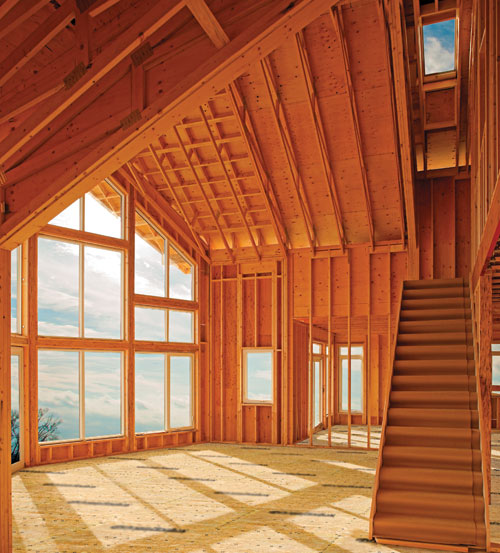 |
Subflooring is a critical structural element that can determine the performance and longevity of the entire flooring system. |
Experts maintain that most hardwood flooring including engineered wood and laminates can be installed directly over 5/8-inch or 3/4-inch-thick plywood subfloors. Engineered or solid wood flooring less than 1/2 inch thick can be installed over a plywood subfloor. However, in the case of a weak subfloor that flexes up and down when walked on, an additional layer of 3/8-inch or 1/2-inch-thick plywood underlayment, glued and screwed down over the weaker subfloor, will add stability. Installing thinner wood flooring over an already weak or thin subfloor may cause the whole floor system to flex up and down when walked on.
Oriented Strand Board
Using 3-inch to 4-inch strands of wood that are also layered and configured in a crossing pattern, then glued and pressed, oriented strand board (OSB) is more dense than plywood and absorbs less moisture. Installation usually consists of gluing and nailing the OSB sheets to the floor joists. Typically, 3/4-inch-thick solid wood flooring is installed directly on top of a 3/4-inch-thick OSB subfloor, with hardwood floors at a 90-degree angle across the floor joists to stabilize and strengthen the whole floor structure. In cases where hardwoods are installed parallel with the floor joists, a second layer of plywood underlayment can be added to increase stability. Alternatively, blocking can be added between the floor joists. When installing engineered, solid, or floating floors that are less than 1/2 inch thick, manufacturers recommend an additional layer of 3/8-inch or 1/2-inch-thick plywood underlayment. The additional underlayment should be glued and screwed down over 3/4-inch-thick OSB subfloor to add stability. As an alternative 2 x 6 blocking can be installed between the floor joists for added stability.
When a roofless, partially built structure takes on water, both plywood and OSB can absorb water, which can lead to swelling and require sanding or replacement before finish flooring can be installed. Many consider OSB more structurally consistent than plywood, as it does not carry the delaminating issues that plywood does. On the other hand, traditional OSB can experience edge swelling when exposed to significant amounts of moisture. According to PATH, a public-private partnership for advancing housing technology, edges—particularly if they are cut edges—can expand by up to 15 percent. In addition, PATH notes that when plywood gets wet, it expands evenly throughout the panel, dries more quickly, and shrinks to its original size more rapidly than OSB.
Concrete Slab
Concrete slabs, which typically consist of a 4- to 6-inch-thick 3,500- to 5,550-pound per square inch (psi)-strength concrete pour, can be susceptible to moisture problems. Because water is used in mixing the newly poured slabs and can take several months to dry out, testing should be performed prior to installation of flooring finish. This can be as simple as taping the several sheets of plastic down in several areas of the slab, and waiting a few days. If moisture develops under the plastic, wood flooring should not be installed until the moisture situation is rectified. Depending on ground water levels, slabs can emit excessive moisture at different times of the year. It's worth noting that slab floors with plastic installed prior to the pour will be more apt to minimize moisture transfer.
It is not recommended that 3/4-inch solid wood flooring be nailed or directly glued down over a concrete slab as floor failure might result from moisture transfer. Alternatively, a “sleeper system” can be built over the slab using wood strips spaced 12 inches apart over which plywood can be placed. In another method, two layers of wood subfloor can be cross-layered diagonally over the slab. In any case, for best results, plastic should be laid down on the slab to retard any moisture transfer from the concrete. For a glue-down engineered wood floor over concrete slab, it is advisable to ensure that the slab has less than 4 percent moisture content year-round. A water-resistant adhesive should also be used.
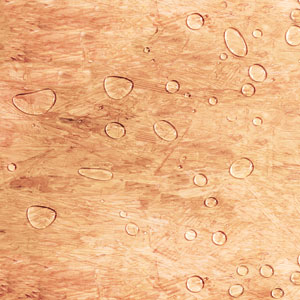 |
Advanced, moisture-resistant resins make water bead up, and not penetrate, high performance subflooring. |
High Performance Panels
High performance panels are engineered products with many of the same characteristics and qualities as OSB and plywood, but with distinct advantages. Developed to address the need for moisture-resistant subflooring, high performance panels are an enhanced OSB product, manufactured with a higher density of wood fiber and special resins integrated into the panel. These enhancements resist water absorption and reduce swelling common to traditional OSB subflooring. Specially engineered through advanced resin technology to resist water absorption, high performance panels minimize not only edge swell, but warping, cupping, and delaminating, thereby eliminating the need for sanding and costly rework. While typically the panels do not need to be sanded due to edge swell, some sanding may be required to ensure levelness of the floor system. Water repellent coatings are not recommended with high performance subflooring.
“Due to severe rain, floods, and snow this year, we have recently faced a very high moisture level in Kentucky. No matter what we tried when building with plywood, we had problems with the floor squeaking, delaminating, and swelling as a result of the moisture,” stated Builder Joe Pusateri of Elite Homes in Louisville, Kentucky. “In the past, we had to add a day into our building scheduling to repair the damaged plywood spots caused by the moisture-related issues. Once we began using high performance subfloors, we were able to remove that step in our building process, which saved us time in the long run to concentrate on other parts of the build and deliver the best possible living environment to the future homeowners.”
In addition to being moisture resistant, high performance panels are a more durable alternative to a traditional plywood or OSB underlayment. Through an optimal balance of density and advanced resin technology, the panels deliver greater stiffness and strength as well as superior nail holding capability. The flooring is available in 19/32-inch, 23/32-inch, 7/8-inch, 1-inch, and 1 1/8-inch thicknesses, and install and remain flat.
Like plywood and OSB, high performance subfloors represent an excellent substrate for a variety of floor coverings including carpet, tile, and hardwood flooring. Wood flooring is glued or nailed directly to the high performance panels or applied after in conjunction with other wood flooring underlayment materials. Architects should note, however, that moisture contents are critical when installing hardwood flooring. Ideally the inside of a home should be HVAC controlled to help with acclimation of the wood products at the time of hardwood flooring installation. To reduce the chances of buckling, cupping, and gapping of the hardwood flooring, the moisture content of the subfloor panels and hardwood flooring should be less than 12 percent before installing hardwood flooring, and ideally the difference in moisture content between them should be within 4 percent. Manufacturers recommend a pin-style moisture meter or similar should be used to determine moisture content of both the high performance subflooring and the hardwood flooring.
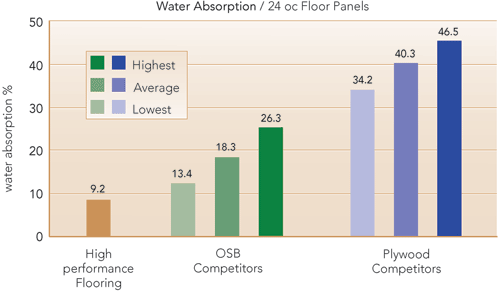 |
All testing was conducted by an independent IAS accredited testing facility in September 2008. This small sample testing wasdone in accordance with the applicable ASTM standards and test methods. OSB values are based on lowest, average and highest water absoption levels of four manufacturers. Plywood value is based on the lowest, average and highest water absorption levelsof three manufacturers. Testing samples correspond to single manufacturing locations from one production date. |
Ceramic tile floors can be particularly challenging as they do not tolerate any type of movement within the subfloor without cracking. With less deflection than plywood or OSB, high performance panels can be a better subfloor option for ceramic tiles. However, ceramic tiles should not be installed directly over high performance panels; an approved underlayment must be installed prior to tile installation. The Tile Council of America Handbook for Ceramic Tile Installation should always be consulted for acceptable methods of tile installation on structural panel substrates.
To the Highest Standard
Architects should be aware of the higher standard to which high performance paneling is certified.
Both plywood and OSB are considered structural panels and treated equally in the building codes. The International Building Code defines OSB as wood structural panels intended for structural use complying with the requirements of Department of Commerce PS 2, Performance Standard for Wood-Based Structural-Use Panels. Section 2303.1.4 of the IBC states that every panel shall be designed and fabricated in accordance with the applicable standard and identified by the trademarks of an approved testing and inspection agency indicating conformance with the applicable standard. Two of the more recognizable companies that have been accredited by the International Accreditation Service (IAS) for testing and inspection of wood structural panels in the U.S. are the Timber Engineering Company (TECO) and APA–The Engineered Wood Association. PS 2 is a voluntary product standard that establishes the performance criteria for structural panels based on their end-application. It details testing procedures to qualify the product and quality control provisions to manufacture the product. All manufacturers of OSB must comply with the requirements outlined in PS 2 and plywood must meet either PS 2 or PS 1.
All approved testing and inspection agencies for wood structural panels, specifically OSB, test and inspect to the same PS 2 standard. When a panel is identified in the grade stamp by the trademark of an approved testing and grading agency, it indicates that the panel conforms to PS 2. Individual testing agencies do not have their own performance standards. They only test to ensure that panels satisfy the requirements of the IBC by ensuring conformance to PS 2. For the purpose of design, panels bearing the trademark of TECO or APA should be considered equally capable of satisfying minimum performance requirements. High performance panels may be subject to meeting performance requirements that exceed the PS 2 minimums and will be indicated by being stamped with an Evaluation Service Report (ESR) number or some other identifying mark.
ESRs are reports issued by evaluation services, like the International Code Council (ICC) Evaluation service, which is the most preferred resource used by code officials to verify that new and innovative building products comply with code requirements. ESRs are mostly referenced by architects, structural engineers, and other design professionals when specifying and selecting building materials. They detail the code requirements or acceptance criteria used to evaluate the new product and the evidence submitted to prove its conformance.
Manufacturers of engineered strand products with properties superior to those established under PS 2 can differentiate their products with an ESR. For years builders have had choices in dimensional lumber selection by product quality via grades—SS, #1, #2. Architects and builders now have the same choices in panel products with an ESR.
ESR 1785 is one example of an evaluation report verifying that high performance panels have greater strength characteristics than panels that meet the minimum PS-2 standard. High performance panels have increased bending strength, bending stiffness, planar shear strength, axial compression strength and stiffness—all prerequisites to building a quiet stiff floor. Bending strength, which represents how much load a panel will hold along the 8-foot length before failure, is a critical component of the overall structural integrity, safety, and longevity of a building. High bending strength helps sustain a quiet, stiff floor over the lifetime of a home.
Bending stiffness represents how much load an engineering subflooring panel will resist bending on the 8-foot length under a heavy load. High bending stiffness will feel firm under foot and will not bounce or sag under a heavy load. Flooring that bounces or sags can crack tile, loosen hardwood flooring nails, and cause vibrations, resulting in floor squeaks and costly rework. As can be seen in the figure below, the bending stiffness of high performance panels outstrips that of plywood and OSB.
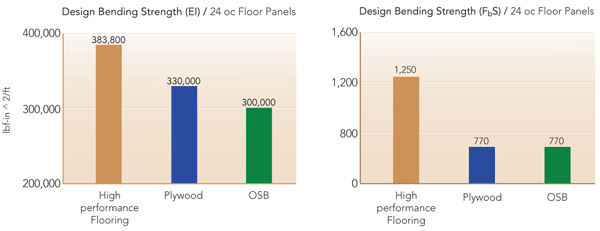 |
A subflooring's strength and stiffness can also lead to lower costs. Mike Hancock of Hancock Building & Design in Edmond, Oklahoma, likes high performance panels for their high strength and minimal deflection. “The product allows me to use thinner sheets for the same cost as thicker plywood products,” Hancock says.
Through evidence submitted on product performance, PS 2 requires a 23/32 OSB subflooring panel to meet a parallel bending strength (EI) of 300,000 lbf-square inch/foot, and plywood subflooring panel to meet 330,000 lbf-square inch/foot. One manufacturer of high performance subflooring, however, engineers, manufactures, and tests to meet a parallel EI of 383,800 lbf-square inch/foot, which is 16 to 28 percent higher than that of plywood and OSB, meaning it offers superior strength and stiffness, less sagging or bounce, and consistent performance when installed on the jobsite.
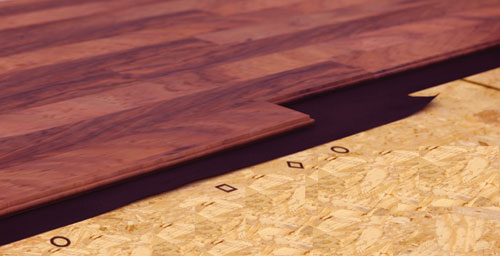 |
High performance subflooring is a suitable substrate for finish flooring options. |
Additionally, APA–The Engineered Wood Association, conducted 2,000 nail-withdrawal tests on OSB and plywood of different thicknesses using different types of nails and over multiple conditions, and determined, through the testing, that the equivalent specific gravity for nail withdrawal strength of APA OSB and plywood is 0.40. High performance panels have shown an equivalent specific gravity of 0.44, which was derived from testing evidence submitted for ESR-1785. This calculated to an allowable nail withdrawal value of 23 lb/inch of thickness for an 8d common nail, so a 23/32 panel would be 16 lb of nail holding strength. APA plywood and OSB only have a value of 13 lb. High performance panels perform more consistently and have greater nail holding capacity than traditional OSB panels meeting the PS-2 minimum standard. This means more structural stability and fewer floor squeaks than plywood or commodity OSB, leading to a smoother, less costly construction process with fewer callbacks.
Shane Lyle of Strathmore Floors in Atlanta, Georgia, specializes in finished flooring services and often handles rework associated with plumbing leaks. He maintains that homebuilders who choose high performance panels for subflooring spend less on construction costs, as it creates less rework for flooring professionals. “Due to rising costs in the construction industry in 2003 and 2004, we saw homebuilders switching from high performance subflooring to commodity oriented strand board because they felt it would decrease building costs,” says Lyle. “We found that the OSB reacts poorly to moisture and many times the subfloors and hardwoods in these homes had to be replaced. To fix the homes, we had to hire a full-time sanding crew, creating expensive and time-consuming rework.”
| High Performance Panels Lead to Customer Satisfaction |
Al Durden, construction supervisor for SF Communities in Macon, Georgia, builds quality, residential homes in Macon and surrounding communities throughout Middle Georgia. Recent alterations in SF Communities’ standard construction practices required Durden to build quieter, energy-efficient homes. By using high performance subflooring and other advanced building materials, Durden was able to meet the new standards and realized significantly increased overall homeowner satisfaction. “high performance subflooring was originally presented to me on trial basis, but after a handful of builds, I’ve personally seen the benefits we can create for our homeowners including quiet, stiff floors and overall a more energy-efficient home,” states Durden. “The subflooring has allowed us to receive 90 percent less warranty calls on squeaking floors. Once we learned through our research that it was the best flooring on the market, we adjusted our overall construction plan to use the product on all of our builds.” Durden says that customers noticed the difference. “Since we began using this subflooring and other energy-efficient building materials, the traffic to our communities has increased due to the curiosity of the product benefits, as well as the positive feedback from our homeowners,” says Durden. |
Implications of Subfloor Characteristics
To fully understand the importance of a proper subfloor, it is important to examine the repercussions of certain issues, including moisture absorption, glues, and installation procedures.
Moisture Resistance: Why It Matters
Moisture that is absorbed by the subfloor during construction—even if it's later dried out when the home is enclosed—can set the stage for situations that are difficult to resolve. Moisture in subflooring can be problematic for a number of reasons, with long-term implications that can weaken the strength and stiffness of the panel, compromising the integrity of the entire flooring.
One of the biggest contributors to moisture problems is damage from snow and rain during construction. Exposure to these elements increases the risk of edge swell, thickness swell, and possible delamination in the subflooring. How severe these problems are depends on the type of subfloor used, with the intent being not to let moisture get a foothold in the wood to begin with. Edge swell, being one of the more common problems in traditional OSB due to excess moisture absorption, can increase the cost for installing finished flooring products because of increased sanding of the subfloor panels. Warping, cupping, and delamination are seen more in plywood and can require the replacement of subfloor panels in extreme cases. Larger projects and harsher climates can equate to long exposure times for subflooring and having a quality subfloor product that can handle these environments is key. high performance panels offering better moisture resistance fare better than traditional OSB and plywood, which are more prone to absorbing water and may require costly replacement. high performance panels offer exposure times up to 500 days and guarantee no sanding due to edge swell.
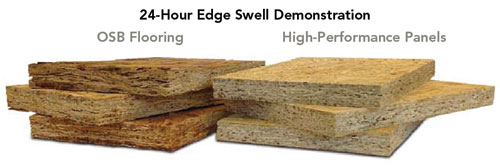 |
Another potential issue with continued exposure to the elements during construction is the effect this moisture can have on the structural strength and nail-holding properties of the subfloor panels. OSB and plywood that are designed to code minimum (PS 2) strength properties have the potential to drop below these code minimums after continued exposure to the elements. high performance panels are designed to provide strength values 16 to 28 percent higher than that of plywood and OSB, meaning that even after continued exposure, these panels will offer superior strength and stiffness, less sagging or bounce, and consistent performance for flooring applications. These panels have a built-in factor of safety to provide additional peace of mind, especially for projects that will be exposed for long periods of time.
Joe Vargo of Joe Vargo Construction LLC in Glenview, Illinois, has used high performance subflooring in more than 400 custom homes. In building a 12-bedroom, 12-bathroom home on Lake Michigan, he needed a floor that would outlast the rainstorms and Chicago winters. Knowing that the build would be exposed to the most extreme of elements for a long period of time, Vargo used high performance flooring. “For this particular build which was 17,000 square feet, we used an entire truckload of the product, which held up to the elements better than expected,” he says. Jon Sasportas, Sasportas Co., Windsor, Connecticut, had a similar experience with harsh weather. “Last October I capped four foundations with high performance panels so we could work through the winter. Over 6 feet of snow and a few ice storms later we are now working on a smooth floor—just like the day it was installed,” says Sasportas.
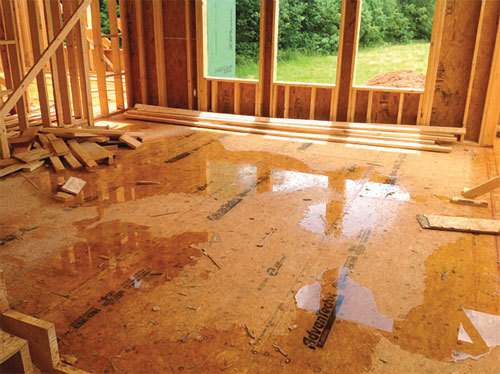 |
Water resistance on high performance panels defends against swelling, cupping, and delamination. |
Subfloor Squeaks. Accounting for a major percentage of complaints from new homeowners, subfloor squeaks are a key cause of callbacks for many homebuilders, resulting in expensive, time-consuming repair. When the weight of the finished floor and the building's occupants are applied to the floor, nails that attach the sub-floor to the joists loosen and rub against the subfloor, causing the squeak. The primary reason for this is the change in moisture content of the lumber from installation to home occupancy. When sub-floor panels remain exposed to the elements at construction sites, they absorb moisture from precipitation or from absorption of moisture in the air. Moisture swells the panels, dislodging the nails. In an occupied home, as the subfloor dries to match the moisture level in the rest of the home, the subfloor shrinks slightly, dislodging the nails used to attach it to the floor joists, causing more nail-against-wood rubbing and audible squeaking.
While moisture from precipitation during construction is virtually unavoidable, certain steps can be taken to minimize the adverse affects on subflooring panels.
Standing Water. In some areas, frequent and lengthy rain storms result in standing water on the floor systems of buildings under construction. Although high performance subfloors will remain dimensionally stable in these conditions, it is best to remove standing water from the floor deck to expedite the drying process.
The use of tarps over the floor deck prior to rainfall may help in the prevention against accumulation of standing water. However, this option is only feasible if wall framing has not been erected.
It is best to use a tented tarp system, which provides air flow underneath the tarp and helps prevent water from collection under the tarp. This can be achieved by the use of temporary framing or blocking below the tarp to create positive drainage and promote air movement for drying under the tarp. Water trapped between the tarp and the decking may contribute to development of mold and mildew. It is best to remove tarps as soon as rainfall has ceased.
The floor deck should be dry prior to installation of finish floor coverings. In removing standing water, there are two main options.
• Sweeping and wet vacuuming are the preferred options for removing standing water on floor decks. Sweeping may be difficult if wall framing has been installed.
• Drilling well-spaced weep holes no greater than 1/2 inch is a common approach but is the least effective method for removing standing water. If the floor deck is relatively flat, the weep hole will only drain water in the immediate vicinity of the hole.
Snow and Ice Accumulation. During winter months, accumulation of snow and ice will not normally affect the structural integrity of high performance panels. Once the ice and snow have melted and the building closed in, it is important to ensure the panels have completely dried prior to finish floor installation. Ice and snow can safely be removed from high performance panels with dark, coarse sand, which will absorb heat from the sun, assist the melting process and can help minimize the possibility of slipping.
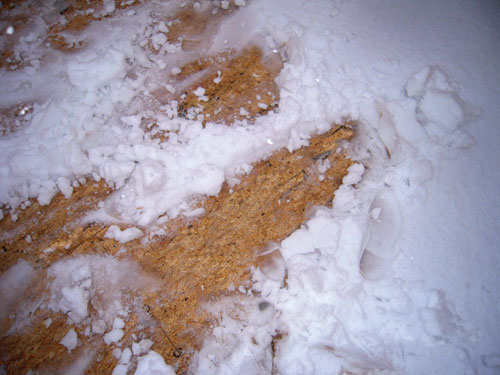 |
High moisture resistance helps high performance panels perform in the harshest weather. |
Glues—A Sustainability Issue
Some subflooring panels are manufactured in accordance with the product standard, PS 2, Performance Standard for Wood-Based Structural-Use Panels. The adhesives used to produce these panels are a combination of exterior type phenol formaldehyde (PF) and isocyanate resins. During manufacturing, PF resins are exposed to heat and pressure. This heat and pressure cures the resin into nonreactive and stable material. Isocyanate resins contain no formaldehyde.
Safety questions or concerns associated with formaldehyde are typically associated with products manufactured using urea formaldehyde such as particleboard, hardwood plywood, and medium-density fiberboard (MDF) moldings. According to the U.S. Department of Housing and Urban Development (HUD), the emission levels for structural wood panels manufactured using phenol formaldehyde are too low to be considered significant. Because of the low emission levels, U.S. HUD has exempted phenolic-bonded wood structural panels from required testing and certification.
The California Air Resources Board (CARB) Air Toxic Control Measure for Wood Products that went into effect on January 1, 2009, is arguably the most restrictive regulation in the United States governing formaldehyde emissions. Sections 93120(b) and 93120.1(a)(8) define the products covered by this regulation as hardwood plywood, particle board, and MDF. OSB products, including high performance panels, are exempt from this regulation.
Installation: Straightforward Measures Lead to Superior Performance
Panels that are not installed properly sacrifice the integrity of the structure. Because nails and screws frequently miss the joints, panels with a printed fastener guide are preferable. High performance panels are available with a pre-marked nailing grid that specifies the location of the joists, eliminating the need to snap lines, which can be difficult in the rain as well as for newer workers in the construction crew. “The grid system means no more chalk lines and no more excuses for missing rows of nails,” says Mike Hancock of Edmond, Oklahoma's Hancock Building & Design.
Another installation benefit of high performance panels is the reduction of the “weak axis” issue. Joists are typically laid out in the same direction within a structure, with subflooring installed perpendicular to the joists to increase the stability of the floor, with the strong axis corresponding to the long side of the 8-foot sheet of subflooring, and the weak axis to the shorter or 4-foot edge. Panels that are inadvertently installed parallel to the structure, along the “weak axis,” can compromise the strength of the flooring system. Instead, panels with above-code strength properties, such as high performance panels, should be selected to avoid this situation. The following figure shows an example of a hypothetical office building with different loads, and how PS 2 parallel strength levels would not meet the requirements in multiple areas.
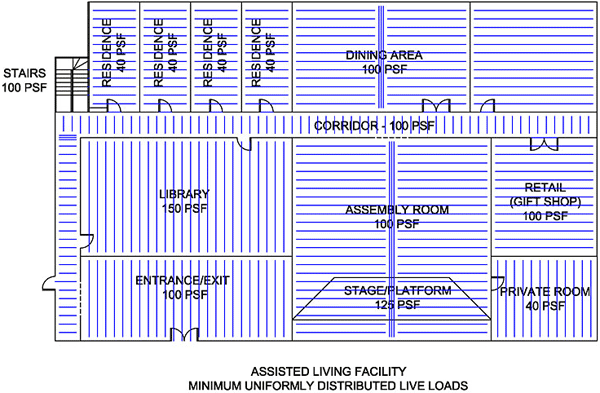 |
| Subflooring in Multifamily and Light Commercial Structures | ||
Floors for multifamily and light commercial structures will typically have four layers with the flooring system: joists, which form the bottom-most layer that supports the entire floor; the subfloor; an underlayment, usually a thin layer of gypsum concrete; and the finish floor. Because the construction process exposes the structure to the elements far longer than for a single-family home, the importance of a subfloor that does not absorb moisture is critical. A low-quality subfloor could lead to issues such as delamination or edge swelling resulting in thin spots and cracks in the gypsum concrete. Drilling small holes in OSB panels to drain standing water may actually cause the gypsum/concrete underlayment to drain to floor below, creating safety issues. In addition, because the gypsum/cementitious underlayment is not structural and only provides sound attenuation, fire resistance, and thermal mass, the subfloor must be sufficiently strong to carry the load. For projects like hotels where floors receive long-term heavy traffic, costly repairs can be reduced by using a high performance subfloor that can resist the abuse over time from traffic as well as from heavy moisture due to extended exposure times. Heavy traffic during construction, particularly concentrated in the corridor areas, can cause severe damage in lower-quality floors. This could result in initial costs during construction to repair the issues and also during the service life of the building if the floor strength is compromised. Replacement of panels in these projects could be particularly costly if swelling occurs due to moisture. The scale is larger, and the thickness swell of 1/8 inch per floor can add up. If this swelling occurs on four floors, that results in a building change of 1/2 inch, a situation that will affect many other aspects of the structure.
|
Subfloors for Superior Performance
The finished floor of a building is only as good as the subfloor beneath it. Ideally, the finished floor will be strong and moisture resistant to avoid problems down the road such as sub-floor squeaks that lead to recalls and repair, and mold and mildew that can cause serious health issues for building occupants. While plywood and traditional OSB have long been mainstays of the subflooring world, high performance panels with increased wood density and enhanced resins exceed the capabilities of traditional subfloor panels in strength, stiffness, nail holding capacity and moisture resistance. Used successfully throughout the U.S. for more than a decade, high performance subflooring offer architects a reliable tool in designing safe, comfortable structures that meet occupants' expectations.
 |
Huber Engineered Woods LLC, a wholly owned subsidiary of J.M. Huber Corporation, combines advanced resin and wood product technologies with state-of-the-art manufacturing capabilities to develop top-quality products like AdvanTech® subflooring and ZIP System® sheathing. Find out more about these innovative products by visiting Huber’s online architect library www.huberarchitectlibrary.com |

